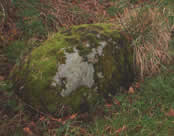
The Four Stones. The Stone circle near Kinnerton consists of four impressively-sized glacial boulders. It is possible that the font in Old Radnor church was made from another originally in this group.

Standing Stone in a field to the south of Kinnerton church

This stone has fallen over and can be found in the verge on a sharp corner of the lane from Kinnerton to Knapp

